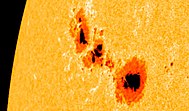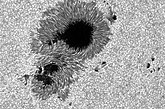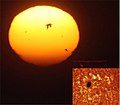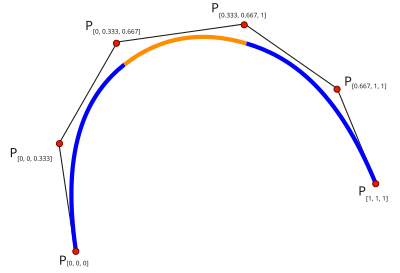From Wikipedia, the free encyclopedia
Single knots at 1/3 and 2/3 establish a spline of three cubic polynomials meeting with C2 continuity. Triple knots at both ends of the interval ensure that the curve interpolates the end points
In
mathematics, a
spline is a
special function defined
piecewise by
polynomials. In
interpolating problems,
spline interpolation is often preferred to
polynomial interpolation because it yields similar results, even when using low degree polynomials, while avoiding
Runge's phenomenon for higher degrees.
In the
computer science subfields of
computer-aided design and
computer graphics, the term spline more frequently refers to a piecewise polynomial
parametric curve[citation needed].
Splines are popular curves in these subfields because of the simplicity
of their construction, their ease and accuracy of evaluation, and their
capacity to approximate complex shapes through
curve fitting and interactive curve design
[citation needed].
The term spline comes from the flexible
spline devices used by shipbuilders and
draftsmen to draw smooth shapes.
[1]
Introduction
The
term "spline" is used to refer to a wide class of functions that are
used in applications requiring data interpolation and/or smoothing. The
data may be either one-dimensional or multi-dimensional. Spline
functions for interpolation are normally determined as the minimizers of
suitable measures of roughness (for example integral squared curvature)
subject to the interpolation constraints.
Smoothing splines
may be viewed as generalizations of interpolation splines where the
functions are determined to minimize a weighted combination of the
average squared approximation error over observed data and the roughness
measure. For a number of meaningful definitions of the roughness
measure, the spline functions are found to be finite dimensional in
nature, which is the primary reason for their utility in computations
and representation. For the rest of this section, we focus entirely on
one-dimensional, polynomial splines and use the term "spline" in this
restricted sense.
Definition
The simplest spline is a
piecewise polynomial function, with each polynomial having a single variable. The spline
S takes values from an interval [
a,
b] and maps them to

, the set of
real numbers,
![{\displaystyle S:[a,b]\to \mathbb {R} .}](https://wikimedia.org/api/rest_v1/media/math/render/svg/408c93e305ecf563c2764bedf9f7365d206c3bf0)
Since
S is piecewise defined, choose
k subintervals to partition [
a,
b]:
![{\displaystyle [t_{i},t_{i+1}]{\mbox{ , }}i=0,\ldots ,k-1}](https://wikimedia.org/api/rest_v1/media/math/render/svg/89611da37419c8db1b71af0f552e396806d313ff)
![{\displaystyle [a,b]=[t_{0},t_{1}]\cup [t_{1},t_{2}]\cup \cdots \cup [t_{k-2},t_{k-1}]\cup [t_{k-1},t_{k}]}](https://wikimedia.org/api/rest_v1/media/math/render/svg/4cd1283f5ea6bce55811b7fa4dcbd746d1b5c4cb)

Each of these subintervals is associated with a polynomial
Pi,
![{\displaystyle P_{i}:[t_{i},t_{i+1}]\to \mathbb {R} }](https://wikimedia.org/api/rest_v1/media/math/render/svg/92d44126644a70c203afc9638659ab15ef87f460) .
.
On the
ith subinterval of [
a,
b],
S is defined by
Pi,




The given
k+1 points
tj (0 ≤
j ≤
k) are called
knots. The vector

is called a
knot vector for the spline. If the knots are equidistantly distributed in the interval [
a,
b] we say the spline is
uniform, otherwise we say it is
non-uniform.
If the
k polynomial pieces
Pi each have degree at most
n, then the spline is said to be of
degree ≤
n (or of
order ≤
n+
1).
If for

in a neighborhood of the
k-1 points
ti, then the spline is said to be of
smoothness (at least)

at
ti. That is, at
ti the two pieces
Pi−1 and
Pi share common derivative values from the derivative of order 0 (the function value) up through the derivative of order
ri (in other words, the two adjacent polynomial pieces connect with
loss of smoothness of at most
n -
ri).
A vector

such that the spline has smoothness

at
ti for

is called a
smoothness vector for the spline.
Given a knot vector

, a degree
n, and a smoothness vector

for

, one can consider the set of all splines of degree

having knot vector

and smoothness vector

.
Equipped with the operation of adding two functions (pointwise
addition) and taking real multiples of functions, this set becomes a
real
vector space. This
spline space is commonly denoted by

.
A knot
ti can be "deleted" by moving it to equal another knot
ti+1. The polynomial piece
Pi(
t) disappears, and the pieces
Pi−1(
t) and
Pi+1(
t) join with the sum of the continuity losses for
ti and
ti+1. That is,
![{\displaystyle S(t)\in C^{n-j_{i}-j_{i+1}}[t_{i}=t_{i+1}],}](https://wikimedia.org/api/rest_v1/media/math/render/svg/20e7a657b5503345d97d0fa55c67ebfc00048e87) where
where 
This leads to a more general understanding of a knot vector. The
continuity loss at any point can be considered to be the result of
multiple knots located at that point, and a spline type can be completely characterized by its degree
n and its
extended knot vector

where
ti is repeated
ji times for

.
A
parametric curve on the interval [
a,
b]
![{\displaystyle G(t)=(X(t),Y(t)){\mbox{ , }}t\in [a,b]}](https://wikimedia.org/api/rest_v1/media/math/render/svg/693bd2eae6b680808285a8ce4c1a23e0ed6d04ef)
is a
spline curve if both
X and
Y are spline functions of the same degree with the same extended knot vectors on that interval.
Examples
Suppose the interval [
a,
b]
is [0,3] and the subintervals are [0,1], [1,2], and [2,3]. Suppose the
polynomial pieces are to be of degree 2, and the pieces on [0,1] and
[1,2] must join in value and first derivative (at
t=1) while the pieces on [1,2] and [2,3] join simply in value (at
t = 2). This would define a type of spline
S(
t) for which



would be a member of that type, and also



would be a member of that type. (Note: while the polynomial piece 2
t
is not quadratic, the result is still called a quadratic spline. This
demonstrates that the degree of a spline is the maximum degree of its
polynomial parts.) The extended knot vector for this type of spline
would be (0, 1, 2, 2, 3).
The simplest spline has degree 0. It is also called a
step function. The next most simple spline has degree 1. It is also called a
linear spline. A closed linear spline (i.e, the first knot and the last are the same) in the plane is just a
polygon.
A common spline is the
natural cubic spline of degree 3 with continuity
C2.
The word "natural" means that the second derivatives of the spline
polynomials are set equal to zero at the endpoints of the interval of
interpolation

Algorithm for computing natural cubic splines
Cubic splines have polynomial pieces of the form
 Given
Given 
coordinates

we find

polynomials

which satisfy
for  :
:
 and
and 



One such polynomial

is given by a 5-tuple

where

and

correspond to the coefficients as used above and

denotes the variable over the appropriate domain
![[x_i,x_{i+1}]](https://wikimedia.org/api/rest_v1/media/math/render/svg/7138606cdb8eb7dddaba59b5aefe1ade6bc05a1b)
.
Computation of Natural Cubic Splines:
Input: a set of

coordinates
Output: a spline as a set of polynomial pieces, each represented by a 5-tuple.
- Create a new array a of size k + 1, and for
 set
set 
- Create new arrays b, d and μ each of size k
- Create a new array h of size k and for
 set
set 
- Create a new array α of size k-1 and for
 set
set 
- Create new arrays c, l, and z each of size
 .
.
- Set

- For

- Set

- Set

- Set

- Set

- For

- Set

- Set

- Set

- Create the spline as a new set of polynomials and call it output_set. Populate it with k 5-tuples for the polynomials P.
- For

- Set Pi,a = ai
- Set Pi,b = bi
- Set Pi,c = ci
- Set Pi,d = di
- Set Pi,x = xi
- Output output_set
Continuity levels
If sampled data from a function or a physical object are available,
spline interpolation is an approach to creating a spline that approximates those data.
Natural continuity
The classical spline type of degree
n used in numerical analysis has continuity
![{\displaystyle S(t)\in \mathrm {C} ^{n-1}[a,b],\,}](https://wikimedia.org/api/rest_v1/media/math/render/svg/1de1fdb04985a749e7e84f051b5ae15a4837b535)
which means that every two adjacent polynomial pieces meet in their value and first
n - 1 derivatives at each knot. The mathematical spline that most closely models the
flat spline is a cubic (
n = 3), twice continuously differentiable (
C2), natural spline, which is a spline of this classical type with additional conditions imposed at endpoints
a and
b.
Reduced continuity
Another type of spline that is much used in graphics, for example in drawing programs such as
Adobe Illustrator from
Adobe Systems, has pieces that are cubic but has continuity only at most
![{\displaystyle S(t)\in \mathrm {C} ^{1}[a,b].}](https://wikimedia.org/api/rest_v1/media/math/render/svg/b56b1ccf157f59e2b3245206a79a8ef784dfd6e1)
This spline type is also used in
PostScript as well as in the definition of some computer typographic fonts.
Many computer-aided design systems that are designed for high-end graphics and animation use extended knot vectors, for example
Maya from
Alias. Computer-aided design systems often use an extended concept of a spline known as a
Nonuniform rational B-spline (NURBS).
Locally negative continuity
It might be asked what meaning more than
n multiple knots in a knot vector have, since this would lead to continuities like

at the location of this high multiplicity. By convention, any such
situation indicates a simple discontinuity between the two adjacent
polynomial pieces. This means that if a knot
ti appears more than
n + 1 times in an extended knot vector, all instances of it in excess of the (
n + 1)th can be removed without changing the character of the spline, since all multiplicities
n + 1,
n + 2,
n
+ 3, etc. have the same meaning. It is commonly assumed that any knot
vector defining any type of spline has been culled in this fashion.
General expression for a C2 interpolating cubic spline
The general expression for the
ith
C2 interpolating cubic spline at a point
x with the natural condition can be found using the formula
+\left[{\frac {f(t_{i-1})}{h_{i}}}-{\frac {z_{i-1}h_{i}}{6}}\right](t_{i}-x)}](https://wikimedia.org/api/rest_v1/media/math/render/svg/d98ff1b6da49994056e5bd034bad792c8f2dc7b5)
where
 are the values of the second derivative at the ith knot.
are the values of the second derivative at the ith knot.
 are the values of the function at the ith knot.
are the values of the function at the ith knot.
Representations and names
For a given interval [
a,
b] and a given extended knot vector on that interval, the splines of degree
n form a
vector space.
Briefly this means that adding any two splines of a given type produces
spline of that given type, and multiplying a spline of a given type by
any constant produces a spline of that given type. The
dimension of the space containing all splines of a certain type can be counted from the extended knot vector:


The dimension is equal to the sum of the degree plus the multiplicities

If a type of spline has additional linear conditions imposed upon it,
then the resulting spline will lie in a subspace. The space of all
natural cubic splines, for instance, is a subspace of the space of all
cubic
C2 splines.
The literature of splines is replete with names for special types of splines. These names have been associated with:
- The choices made for representing the spline, for example:
- The choices made in forming the extended knot vector, for example:
- using single knots for Cn-1 continuity and spacing these knots evenly on [a,b] (giving us uniform splines)
- using knots with no restriction on spacing (giving us nonuniform splines)
- Any special conditions imposed on the spline, for example:
- enforcing zero second derivatives at a and b (giving us natural splines)
- requiring that given data values be on the spline (giving us interpolating splines)
Often a special name was chosen for a type of spline satisfying two or more of the main items above. For example, the
Hermite spline
is a spline that is expressed using Hermite polynomials to represent
each of the individual polynomial pieces. These are most often used with
n = 3; that is, as
Cubic Hermite splines. In this degree they may additionally be chosen to be only tangent-continuous (
C1);
which implies that all interior knots are double. Several methods have
been invented to fit such splines to given data points; that is, to make
them into interpolating splines, and to do so by estimating plausible
tangent values where each two polynomial pieces meet (giving us
Cardinal splines,
Catmull-Rom splines, and
Kochanek-Bartels splines, depending on the method used).
For each of the representations, some means of evaluation must be
found so that values of the spline can be produced on demand. For those
representations that express each individual polynomial piece
Pi(
t) in terms of some basis for the degree
n polynomials, this is conceptually straightforward:
- For a given value of the argument t, find the interval in which it lies
![{\displaystyle t\in [t_{i},t_{i+1}]}](https://wikimedia.org/api/rest_v1/media/math/render/svg/c74ba28db7893372d54339c022fa854065c38302)
- Look up the polynomial basis chosen for that interval

- Find the value of each basis polynomial at t:

- Look up the coefficients of the linear combination of those basis polynomials that give the spline on that interval c0, ..., ck-2
- Add up that linear combination of basis polynomial values to get the value of the spline at t:

However, the evaluation and summation steps are often combined in
clever ways. For example, Bernstein polynomials are a basis for
polynomials that can be evaluated in linear combinations efficiently
using special recurrence relations. This is the essence of
De Casteljau's algorithm, which features in
Bézier curves and Bézier splines.
For a representation that defines a spline as a linear combination of
basis splines, however, something more sophisticated is needed. The
de Boor algorithm is an efficient method for evaluating
B-splines.
History
Before computers were used, numerical calculations were done by hand. Although piecewise-defined functions like the
sign function or
step function
were used, polynomials were generally preferred because they were
easier to work with. Through the advent of computers splines have gained
importance. They were first used as a replacement for polynomials in
interpolation, then as a tool to construct smooth and flexible shapes in
computer graphics.
It is commonly accepted that the first mathematical reference to splines is the 1946 paper by
Schoenberg,
which is probably the first place that the word "spline" is used in
connection with smooth, piecewise polynomial approximation. However, the
ideas have their roots in the aircraft and shipbuilding industries. In
the foreword to (Bartels et al., 1987),
Robin Forrest describes "
lofting", a technique used in the British aircraft industry during
World War II to construct templates for airplanes by passing thin wooden strips (called "
splines")
through points laid out on the floor of a large design loft, a
technique borrowed from ship-hull design. For years the practice of ship
design had employed models to design in the small. The successful
design was then plotted on graph paper and the key points of the plot
were re-plotted on larger graph paper to full size. The thin wooden
strips provided an interpolation of the key points into smooth curves.
The strips would be held in place at discrete points (called "ducks" by
Forrest; Schoenberg used "dogs" or "rats") and between these points
would assume shapes of minimum strain energy. According to Forrest, one
possible impetus for a mathematical model for this process was the
potential loss of the critical design components for an entire aircraft
should the loft be hit by an enemy bomb. This gave rise to "conic
lofting", which used conic sections to model the position of the curve
between the ducks. Conic lofting was replaced by what we would call
splines in the early 1960s based on work by
J. C. Ferguson at
Boeing and (somewhat later) by
M. A. Sabin at
British Aircraft Corporation.
The word "spline" was originally an
East Anglian dialect word.
[citation needed]
The use of splines for modeling automobile bodies seems to have several independent beginnings. Credit is claimed on behalf of
de Casteljau at
Citroën,
Pierre Bézier at
Renault, and
Birkhoff,
Garabedian, and
de Boor at
General Motors
(see Birkhoff and de Boor, 1965), all for work occurring in the very
early 1960s or late 1950s. At least one of de Casteljau's papers was
published, but not widely, in 1959. De Boor's work at
General Motors resulted in a number of papers being published in the early 1960s, including some of the fundamental work on
B-splines.
Work was also being done at Pratt & Whitney Aircraft, where two
of the authors of (Ahlberg et al., 1967)—the first book-length treatment
of splines—were employed, and the
David Taylor Model Basin, by Feodor Theilheimer. The work at
General Motors is detailed nicely in (Birkhoff, 1990) and (Young, 1997). Davis (1997) summarizes some of this material.

















![{\displaystyle S:[a,b]\to \mathbb {R} .}](https://wikimedia.org/api/rest_v1/media/math/render/svg/408c93e305ecf563c2764bedf9f7365d206c3bf0)
![{\displaystyle [t_{i},t_{i+1}]{\mbox{ , }}i=0,\ldots ,k-1}](https://wikimedia.org/api/rest_v1/media/math/render/svg/89611da37419c8db1b71af0f552e396806d313ff)
![{\displaystyle [a,b]=[t_{0},t_{1}]\cup [t_{1},t_{2}]\cup \cdots \cup [t_{k-2},t_{k-1}]\cup [t_{k-1},t_{k}]}](https://wikimedia.org/api/rest_v1/media/math/render/svg/4cd1283f5ea6bce55811b7fa4dcbd746d1b5c4cb)

![{\displaystyle P_{i}:[t_{i},t_{i+1}]\to \mathbb {R} }](https://wikimedia.org/api/rest_v1/media/math/render/svg/92d44126644a70c203afc9638659ab15ef87f460)













![{\displaystyle S(t)\in C^{n-j_{i}-j_{i+1}}[t_{i}=t_{i+1}],}](https://wikimedia.org/api/rest_v1/media/math/render/svg/20e7a657b5503345d97d0fa55c67ebfc00048e87)



![{\displaystyle G(t)=(X(t),Y(t)){\mbox{ , }}t\in [a,b]}](https://wikimedia.org/api/rest_v1/media/math/render/svg/693bd2eae6b680808285a8ce4c1a23e0ed6d04ef)























![[x_i,x_{i+1}]](https://wikimedia.org/api/rest_v1/media/math/render/svg/7138606cdb8eb7dddaba59b5aefe1ade6bc05a1b)















![{\displaystyle S(t)\in \mathrm {C} ^{n-1}[a,b],\,}](https://wikimedia.org/api/rest_v1/media/math/render/svg/1de1fdb04985a749e7e84f051b5ae15a4837b535)
![{\displaystyle S(t)\in \mathrm {C} ^{1}[a,b].}](https://wikimedia.org/api/rest_v1/media/math/render/svg/b56b1ccf157f59e2b3245206a79a8ef784dfd6e1)







![{\displaystyle t\in [t_{i},t_{i+1}]}](https://wikimedia.org/api/rest_v1/media/math/render/svg/c74ba28db7893372d54339c022fa854065c38302)




